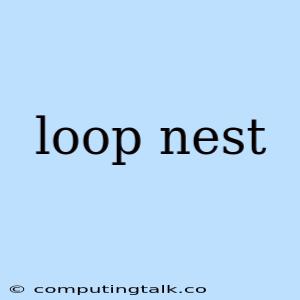Loop nests are fundamental constructs in programming, particularly in languages like C, C++, Java, and Python. They play a crucial role in performing repetitive tasks and iterating over data structures. Understanding the intricacies of loop nests is essential for optimizing code performance and writing efficient algorithms.
What is a Loop Nest?
A loop nest refers to a structure where one or more loops are nested within each other. This means that the inner loop is executed completely for each iteration of the outer loop. For instance, a loop nest with two loops might look like this:
for i in range(5):
for j in range(3):
print(i, j)
In this example, the inner loop iterating over j runs three times for each iteration of the outer loop iterating over i. Consequently, the print statement is executed 15 times (5 x 3).
Types of Loop Nests
Loop nests can be classified based on the number of loops involved:
-
Single Loop Nest: This is the simplest form, where only one loop exists. It is used for iterating over a single data structure or performing a task a fixed number of times.
-
Double Loop Nest: This type involves two nested loops. It's commonly used for tasks involving two-dimensional data structures like matrices or for performing operations involving pairs of elements.
-
Triple Loop Nest: This type involves three nested loops. It's used for tasks involving three-dimensional data structures or for performing operations involving three-dimensional data.
-
Multi-Loop Nest: This encompasses any loop nest with more than three loops. It's often encountered in complex algorithms or applications working with multi-dimensional data.
Importance of Loop Nests
Loop nests are vital for various reasons:
-
Iteration: They enable repetitive execution of code blocks, making them ideal for handling data structures like arrays, lists, or matrices.
-
Algorithms: Many algorithms, such as sorting and searching, rely heavily on loop nests for their implementation.
-
Data Processing: Loop nests are instrumental in processing large amounts of data, performing operations on each data element.
-
Optimization: Optimizing loop nests can significantly improve code efficiency and speed up program execution.
Optimizing Loop Nests
Optimizing loop nests is crucial for maximizing code performance. Here are some key techniques:
-
Loop Fusion: Combining multiple loops into a single loop can reduce overhead and improve performance, especially when the loops process the same data.
-
Loop Unrolling: Expanding the loop body to execute multiple iterations in a single step can reduce loop overhead and improve performance for simple loops.
-
Loop Interchange: Changing the order of nested loops can sometimes improve data locality and cache utilization, resulting in better performance.
-
Loop Vectorization: This technique involves transforming loop operations into vector operations, which can be executed much faster on modern processors with vector units.
Challenges with Loop Nests
While powerful, loop nests can present challenges:
-
Complexity: Understanding and debugging complex nested loops can be difficult, especially when multiple variables are involved.
-
Performance: Unoptimized loop nests can lead to inefficient code and slow execution times.
-
Memory Access: Nested loops can create memory access patterns that are not optimal for modern processors, leading to cache misses and performance degradation.
Tips for Effective Loop Nest Usage
-
Understand Your Data: Analyze the structure of your data and how it's processed to determine the most efficient loop structure.
-
Optimize for Locality: Consider data access patterns and try to improve data locality by rearranging loops or accessing data in a more organized manner.
-
Use Profiling Tools: Employ profiling tools to identify performance bottlenecks in your code and pinpoint areas where loop optimization can make the biggest impact.
-
Experiment with Different Techniques: Explore various loop optimization techniques and experiment with different strategies to find the most effective approach for your specific code.
Example of a Loop Nest for Matrix Multiplication
def matrix_multiply(A, B):
rows_A = len(A)
cols_A = len(A[0])
rows_B = len(B)
cols_B = len(B[0])
# Check if matrix dimensions are compatible
if cols_A != rows_B:
raise ValueError("Matrices cannot be multiplied.")
# Create the result matrix
C = [[0 for _ in range(cols_B)] for _ in range(rows_A)]
# Perform matrix multiplication
for i in range(rows_A):
for j in range(cols_B):
for k in range(cols_A):
C[i][j] += A[i][k] * B[k][j]
return C
# Example matrices
A = [[1, 2], [3, 4]]
B = [[5, 6], [7, 8]]
# Calculate the product matrix
C = matrix_multiply(A, B)
# Print the result matrix
for row in C:
print(row)
In this code, we have a triple loop nest (the for loops iterating over i, j, and k) to perform matrix multiplication. The innermost loop (iterating over k) calculates the dot product of the ith row of A and the jth column of B, which contributes to the element at C[i][j].
Conclusion
Loop nests are powerful constructs in programming that enable efficient iteration and data processing. By understanding their fundamentals, types, and optimization techniques, you can write optimized code for various applications. While nested loops can be complex to handle, they offer significant advantages in terms of code clarity and performance when used effectively. Mastering loop nests is essential for achieving efficient algorithms and high-performance applications.
